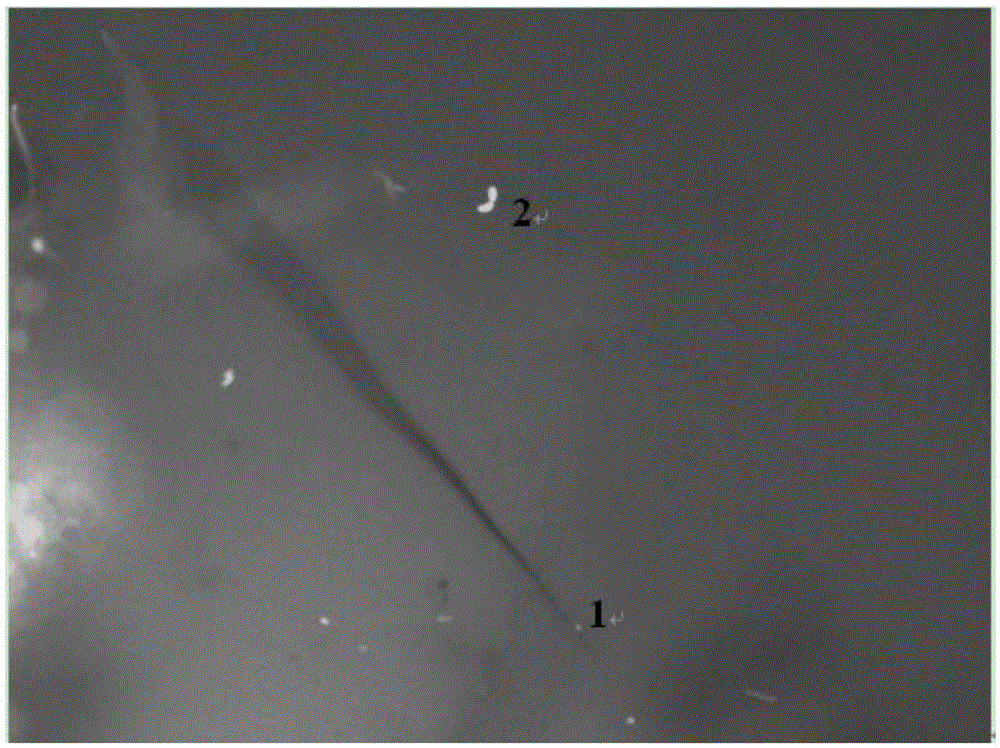Method for quick acquisition of conidia
A technology for conidia and spores, which is applied in the field of extremely rapid acquisition of conidia, can solve the problems of not pursuing the yield of conidia, and in-depth research on the temperature, humidity and nutrient conditions of the spore-producing environment without microcirculation, so as to avoid contamination or contamination. The effect of changes in bacterial species traits and short sporulation cycle
- Summary
- Abstract
- Description
- Claims
- Application Information
AI Technical Summary
Problems solved by technology
Method used
Image
Examples
Embodiment 1
[0026] Get freshly collected ascospores, dilute them with 2% glycerin aqueous solution to a concentration of 4500 / ml ascospores solution; smear the ascospores solution evenly on the body surface of 50 3rd instar healthy bat moth larvae with a pre-sterilized fine brush , the amount of smearing for each worm is 20 μ l, and the bat moth larvae after smearing are placed in clean petri dishes with a cover that are moistened with filter paper. The humidity of the filter paper is controlled within the range of full wetting, full but not overflowing. Check every day, and add water according to the moisture status of the filter paper. The culture was carried out in a clean area with a temperature of 14°C and a relative humidity of 65%, protected from light. Real-time monitoring of sporulation using a fluorescence microscope (see attached figure 1 shown), stop culturing at 24h, and use 0.003mol / lKH containing 0.1% Tween 80 2 PO 4 The buffer solution elutes the conidia, and the larva...
Embodiment 2
[0028] Get freshly collected ascospores and dilute them with 3% glycerol aqueous solution to a concentration of 5000 / ml ascospores solution; use a pre-sterilized fine brush to evenly smear the ascospores solution on the body surface of 50 4th instar healthy bat moth larvae , the amount of smearing for each worm is 20 μ l, and the bat moth larvae after smearing are placed in clean petri dishes with a cover that are moistened with filter paper. The humidity of the filter paper is controlled within the range of full wetting, full but not overflowing. Check every day, and add water according to the moisture status of the filter paper. The culture was carried out in a clean area with a temperature of 15°C and a relative humidity of 70%, protected from light. Use a fluorescence microscope to monitor the sporulation situation in real time, stop the cultivation at 54h, and use 0.003mol / lKH containing 0.1% Tween 80 2 PO 4 The buffer solution elutes the conidia, and the larvae are pu...
Embodiment 3
[0030] Get freshly collected ascospores and dilute them with 4% aqueous glycerin solution to form an ascospore solution with an ascospore concentration of 5500 / ml; use a pre-sterilized fine brush to evenly smear the ascospore solution on 50 5th instar healthy bat moth larvae On the body surface, the amount of smearing for each worm is 25 μl, and the smeared bat moth larvae are respectively placed in a clean petri dish with a cover that is moistened with filter paper. The humidity of the filter paper is controlled within the range of full wetting, full but not overflowing. Check every day, and add water according to the moisture status of the filter paper. The culture was carried out in a clean area with a temperature of 16°C and a relative humidity of 75%, protected from light. Use a fluorescence microscope to monitor the sporulation situation in real time, stop the cultivation at 48h, and use 0.003mol / lKH containing 0.1% Tween 80 2 PO 4 The buffer solution elutes the conid...
PUM
 Login to View More
Login to View More Abstract
Description
Claims
Application Information
 Login to View More
Login to View More - R&D
- Intellectual Property
- Life Sciences
- Materials
- Tech Scout
- Unparalleled Data Quality
- Higher Quality Content
- 60% Fewer Hallucinations
Browse by: Latest US Patents, China's latest patents, Technical Efficacy Thesaurus, Application Domain, Technology Topic, Popular Technical Reports.
© 2025 PatSnap. All rights reserved.Legal|Privacy policy|Modern Slavery Act Transparency Statement|Sitemap|About US| Contact US: help@patsnap.com

